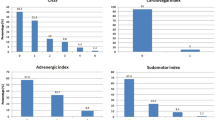Abstract
Background
Multiple sclerosis (MS) has been reported to be associated with extensive autonomic dysfunction as well as to involve the cardiovascular system. In this study we compared P wave duration and dispersion (PWD) of MS patients to healthy control subjects.
Method
Thirty-one MS patients (mean age 35±9 years) and 33 healthy control subjects (mean age 34±7 years) were included in the study. Twelve-lead surface ECG recording (paper speed of 50 mm/s) was obtained from all participants. The change in maximum and minimum P wave duration was measured manually and the difference between the two values was defined as PWD.
Results
There was no difference between the two groups in terms of baseline demographic characteristics. Maximum P wave duration was higher in MS patients than controls (126±6 vs. 122±5 ms, p=0.004). Minimum P wave duration was found to be similar in MS patients and healthy controls (72±8 vs. 75±8 ms, p=0.2).Mean PWD value of MS patients was also found to be higher than those of controls (53±10 vs. 47±10 ms, p=0.01).
Conclusion
P wave duration and PWD was found to be statistically different in patients with MS and control subjects.
Similar content being viewed by others
References
Anema JR, Heijenbrok MW, Feas TJ, Heimans JJ, Lanting P, Polman CH (1991) Cardiovascular autonomic function in multiple sclerosis. J Neurol Sci 104:129–134
Aytemir K, Ozer N, Atalar E, Sade E, Aksoyek S, Ovunc K, Oto A, Ozmen F, Kes S (2000) P wave dispersion on 12-lead electrocardiography in patients with paroxysmal atrial fibrillation. Pacing Clin Electrophysiol 23:1109–1112
Cartlide NEF (1972) Autonomic function in multiple sclerosis. Brain 95:661–664
Chagnac Y, Martinovitis G, Tadmor R, Goldhammer Y (1986) Paroxysmal atrial fibrillation associated with an attack of multiple sclerosis. Postgrad Med J 62:385–387
Cheema AN, Ahmed MW, Kadish AH, Goldberger JJ (1990) Effects of autonomic stimulation and blockade on signal-averaged P wave duration. J Am Coll Cardiol 26:497–502
Dilaveris PE, Gialafos EJ, Andrikopoulos GK, Richter DJ, Papanikolaou V, Poralis K, Gialafos JE (2000) Clinical and electrocardiographic predictors of recurrent atrial fibrillation. Pacing Clin Electrophysiol 23:352–358
Dilaveris PE, Gialafos EJ, Sideris S, Theopistou AM, Andrikopoulos GK, Kyriakidis M, Gialafos JE, Toutouzas PK (1998) Simple electrocardiographic markers for the prediction of paroxysmal idiopathic atrial fibrillation. Am Heart J 135:733–738
Dilaveris PE, Gialofos JE (2001) P-wave dispersion: a novel predictor of paroxysmal atrial fibrillation. Ann Noninvasive Electrocardiol 6:159–165
Drouin E, Nataf S, Lande G, Louboutin JP (1998) Abnormalities of cardiovascular repolarization in multiple sclerosis: relationship with a model of allergic encephalomyelitis in rat. Muscle Nerve 21:940–942
Flachenecker P, Wolf A, Krauser M, Hartung HP, Reiners K (1999) Cardiovascular autonomic dysfunction in multiple sclerosis: correlation with orthostatic intolerance. J Neurol 246:578–586
Frontoni M, Fiorini M, Strano S, Cerutti S, Giubilei F, Urani C, Bastianello S, Pozzilli C (1996) Power spectrum analysis contribution to the detection of cardiovascular dysautonomia in multiple sclerosis. Acta Neurol Scand 93:241–245
Gunal DI, Afsar N, Tanridag T, Aktan S (2002) Autonomic dysfunction in multiple sclerosis: correlation with disease-related parameters. Eur Neur 28:1–5
Karaszewski JW, Reder AT, Anlar B, Arnason BG (1993) Increased high affinity beta-adrenergic receptor densities and cyclic AMP responses of CD8 cells in multiple sclerosis. J Neuroimmunol 43:1–7
Leier CV, Meacham JA, Schall SF (1978) Prolonged atrial conduction: A major predisposing factor to atrial flutter. Circulation 57:213–216
McDougall AJ, McLeod JG (2003) Autonomic nervous system function in multiple sclerosis. J Neurol Sci 215:79–85
Monge-Argiles JA, Palacios-Ortega F, Vila-Sobrino JA, Matias-Guiu J (1998) Heart rate variability in multiple sclerosis during a stable phase. Acta Neurol Scand 97:86–92
Nordenbo AM, Boesen F, Anderson EB (1989) Cardiovascular autonomic functions in multiple sclerosis. J Auton Nerv Syst 26:82–86
Pentland B, Ewing DJ (1987) Cardiovascular reflexes in multiple sclerosis. Eur Neurol 26:46–50
Pozzessere G, Rossi P, Vale E, Froio CP, Petrucci AF, Morocutti C (1997) Autonomic involvement in multiple sclerosis: a pupillometric study. Clin Auton Res 7:315–319
Saari A, Tolonen U, Paakko E, Souminen K, Pyhtinen J, Sotoniemi K, Myllyla V (2004) Cardiovascular autonomic dysfunction correlates with brain MRI lesion load in MS. Clin Neurophysiol 115:1473–1478
Schroth WS, Tenner SM, Rappaport BA, Mani R (1992) Multiple sclerosis as a cause of atrial fibrillation and electrocardiographic changes. Arch Neurol 49:422–424
Thomaides TN, Zoukos Y, Chaudhuri KR, Mathias CJ (1993) Physiological assessment of aspects of autonomic function in patients with secondary progressive multiple sclerosis. J Neurol 240:139–143
Tukek T, Akkaya V, Demirel S, Sozen AB, Kudat H, Atılgan D, Ozcan M, Guven O, Korkut F (2000) Effect of valsalva maneuver on surface electrocardiographic P wave dispersion in paroxysmal atrial fibrillation. Am J Cardiol 85:896–899
Author information
Authors and Affiliations
Corresponding author
Rights and permissions
About this article
Cite this article
Kocer, A., Karakaya, O., Kargin, R. et al. P wave duration and dispersion in multiple sclerosis. Clin Auton Res 15, 382–386 (2005). https://doi.org/10.1007/s10286-005-0283-6
Received:
Accepted:
Issue Date:
DOI: https://doi.org/10.1007/s10286-005-0283-6




